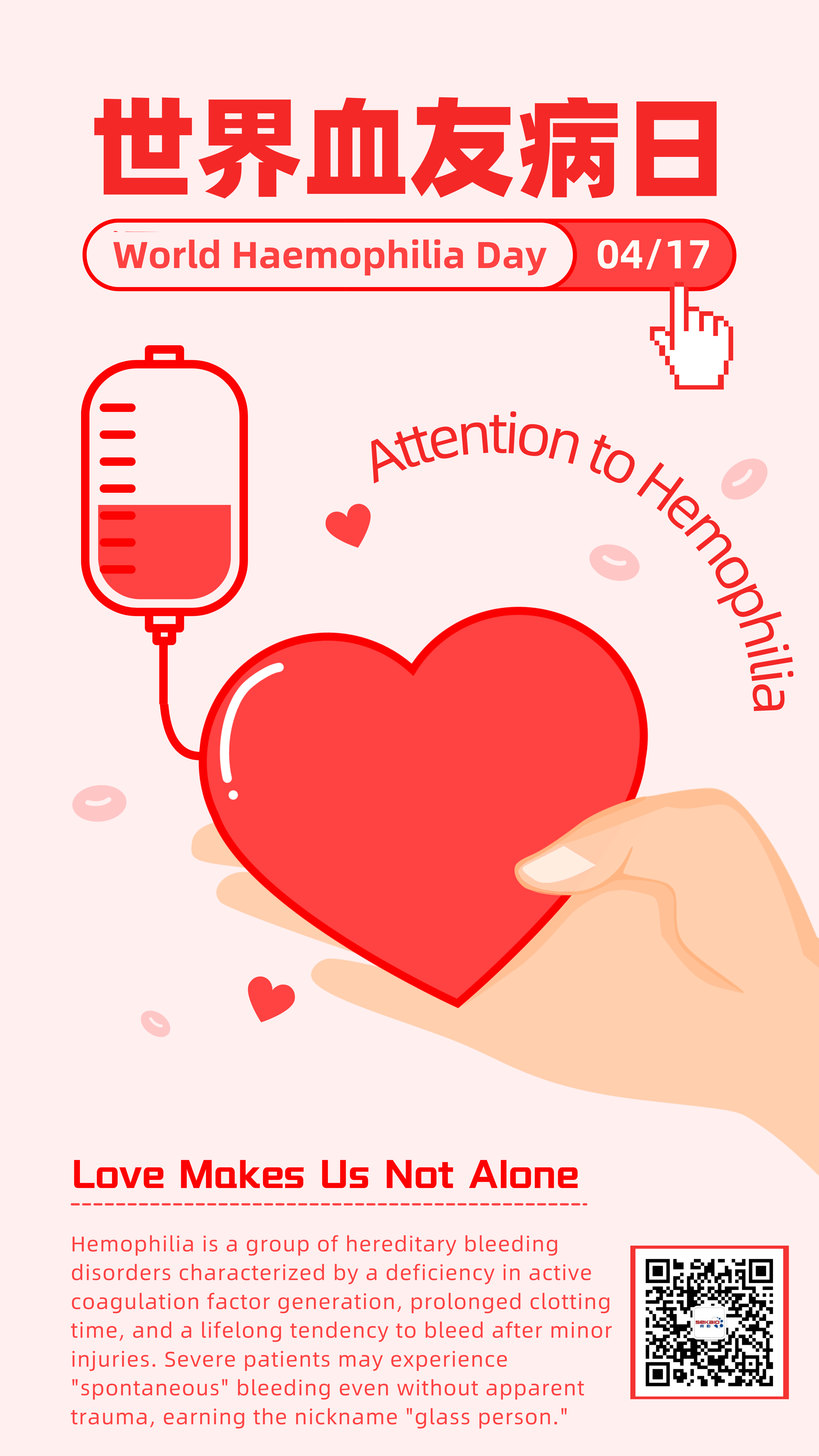World Hemophilia Day : Raise Awareness of Bleeding Disorders
April 17, 2024 marks the 36th "World Hemophilia Day" with the theme "Understanding Bleeding Disorders, Proactively Preventing and Treating".

Bleeding Disorders
Bleeding disorders are characterized by spontaneous or excessive bleeding following minor injuries due to defects or abnormalities in the hemostatic mechanisms involving blood vessels, platelets, coagulation, anticoagulation, and fibrinolysis, caused by congenital, hereditary, or acquired factors.
1. Congenital or Hereditary:
Including hereditary hemorrhagic telangiectasia, Ehlers-Danlos syndrome, systemic diffuse angiomatosis, hereditary hemorrhagic telangiectasia, purpura simplex, infectious purpura, etc.
2. Acquired:
Such as allergic purpura, vitamin C deficiency, mechanical purpura, CREST syndrome (calcinosis, Raynaud's phenomenon, esophageal motility disorder, sclerodactyly, and telangiectasia), senile purpura, and thrombocytopenic purpura.
Normal Hemostatic Mechanism
Under normal circumstances, the body has an intact hemostatic mechanism and does not experience spontaneous bleeding. Physiological hemostatic mechanisms mainly include vascular constriction, platelet thrombus formation, and fibrin clot formation and maintenance. Based on vascular constriction, platelets adhere and aggregate at the site of vascular injury, a process called primary hemostasis. Almost simultaneously, the coagulation system is activated, and the final product of plasma coagulation, the fibrin mesh, is formed to reinforce the platelet thrombus, called secondary hemostasis.
Etiological Analysis
The etiology of bleeding disorders is complex and varied, mainly including:
lPlatelet decrease or dysfunction: Hereditary bleeding disorders are often due to familial inheritance or autoimmune genetic defects leading to significant platelet decrease or dysfunction; acquired bleeding disorders are mostly due to other diseases or drugs causing platelet production disorders, excessive destruction, excessive consumption, or dysfunction.
lVascular wall abnormalities: Hereditary includes hereditary hemorrhagic telangiectasia, congenital connective tissue diseases, etc.; acquired mainly due to severe infections, allergies, drug toxic side effects, and immune system diseases.
lCoagulation dysfunction: Hereditary includes hereditary coagulation factor deficiency represented by hemophilia; acquired mainly due to liver and kidney diseases, immune system diseases, leading to coagulation dysfunction.
lExcessive activity of anticoagulants.
Recommended Testing Items
1. Endothelial, coagulation, and fibrinolysis function: thrombin-antithrombin III complex (TAT), plasmin-α2 plasmin inhibitor complex (PIC), tissue-type plasminogen activator-plasminogen activator inhibitor-1 complex (t-PAIC), thrombomodulin (TM).
2. Platelet function: Antiplatelet antibody IgG.
The four thrombosis items are produced in the initial stage of the coagulation and fibrinolysis systems, and can be used as early molecular markers of the disease to comprehensively evaluate the coagulation, fibrinolysis, and vascular endothelial damage.
Antiplatelet antibody IgG reflects platelet function. The joint detection of the four thrombosis items and antiplatelet antibody IgG can analyze the etiology of bleeding disorders, which is conducive to disease screening, medication guidance, and efficacy evaluation.
Disease Prevention
lAvoid the use of any drugs that may impair hemostatic function, such as aspirin and other nonsteroidal anti-inflammatory drugs, especially during bleeding episodes.
lProper preventive care, including screening for common age-related comorbidities and related risk factors.
lRegular examinations of joints, bones, muscles, dentistry, and blood-related conditions.
lSome conditions require special attention and active prevention and treatment in patients with bleeding disorders, such as untreated severe hypertension, which may lead to intracranial hemorrhage.
lBefore performing invasive prevention or examination procedures on patients with bleeding disorders, consult a hematologist to determine if systemic hemostatic prophylactic medication is needed.
lEligible patients may undergo regular preventive treatment for relevant diseases, such as hemophilia A and B patients, who may prophylactically supplement coagulation factors VIII or IX (FVIII or FIX). There are three types of hemophilia A, hemophilia B, and hemophilia C. Among them, hemophilia A (Hernophilia A), also known as coagulation factor VIII deficiency or antihemophilia factor A (Antihemophilia facorA) deficiency. Genuine hemophilia and anti-hemophilia globulin deficiency are traditional hemophilias; hemophilia B is also known as coagulation factor IX deficiency or plasma coagulation factor (PIC) deficiency; hemophilia C is also known as coagulation factor XI deficiency, plasma coagulation factor precursors (PTA) deficiency. Among congenital bleeding disorders, hemophilia is the most common, especially hemophilia A, accounting for about 85%, followed by hemophilia B, and the least common is hemophilia C.

















